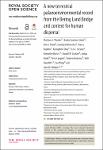A new terrestrial palaeoenvironmental record from the Bering Land Bridge and context for human dispersal
| dc.contributor.author | Wooller, MJ | |
| dc.contributor.author | Saulnier-Talbot, É | |
| dc.contributor.author | Potter, BA | |
| dc.contributor.author | Belmecheri, S | |
| dc.contributor.author | Bigelow, N | |
| dc.contributor.author | Choy, K | |
| dc.contributor.author | Cwynar, LC | |
| dc.contributor.author | Davies, K | |
| dc.contributor.author | Graham, RW | |
| dc.contributor.author | Kurek, J | |
| dc.contributor.author | Langdon, P | |
| dc.contributor.author | Medeiros, A | |
| dc.contributor.author | Rawcliffe, R | |
| dc.contributor.author | Wang, Y | |
| dc.contributor.author | Williams, JW | |
| dc.date.accessioned | 2024-04-24T09:28:33Z | |
| dc.date.available | 2024-04-24T09:28:33Z | |
| dc.date.issued | 2018-06-20 | |
| dc.identifier.issn | 2054-5703 | |
| dc.identifier.issn | 2054-5703 | |
| dc.identifier.other | ARTN 180145 | |
| dc.identifier.uri | https://pearl.plymouth.ac.uk/handle/10026.1/22297 | |
| dc.description.abstract |
© 2018 The Authors. Palaeoenvironmental records from the now-submerged Bering Land Bridge (BLB) covering the Last Glacial Maximum (LGM) to the present are needed to document changing environments and connections with the dispersal of humans into North America. Moreover, terrestrially based records of environmental changes are needed in close proximity to the re-establishment of circulation between Pacific and Atlantic Oceans following the end of the last glaciation to test palaeo-climate models for the high latitudes. We present the first terrestrial temperature and hydrologic reconstructions from the LGM to the present from the BLB’s south-central margin. We find that the timing of the earliest unequivocal human dispersals into Alaska, based on archaeological evidence, corresponds with a shift to warmer/wetter conditions on the BLB between 14 700 and 13 500 years ago associated with the early Bølling/Allerød interstadial (BA). These environmental changes could have provided the impetus for eastward human dispersal at that time, from Western or central Beringia after a protracted human population standstill. Our data indicate substantial climate-induced environmental changes on the BLB since the LGM, which would potentially have had significant influences on megafaunal and human biogeography in the region. | |
| dc.format.extent | 180145-180145 | |
| dc.format.medium | Electronic-eCollection | |
| dc.language | en | |
| dc.publisher | Royal Society, The | |
| dc.subject | Beringia | |
| dc.subject | stable isotopes | |
| dc.subject | diatoms | |
| dc.subject | cladocerans | |
| dc.subject | chironomids | |
| dc.subject | environmental change | |
| dc.title | A new terrestrial palaeoenvironmental record from the Bering Land Bridge and context for human dispersal | |
| dc.type | Journal Article | |
| plymouth.author-url | https://www.ncbi.nlm.nih.gov/pubmed/30110451 | |
| plymouth.issue | 6 | |
| plymouth.volume | 5 | |
| plymouth.publication-status | Published | |
| plymouth.journal | Royal Society Open Science | |
| dc.identifier.doi | 10.1098/rsos.180145 | |
| plymouth.organisational-group | |Plymouth | |
| plymouth.organisational-group | |Plymouth|Faculty of Science and Engineering | |
| plymouth.organisational-group | |Plymouth|Users by role | |
| plymouth.organisational-group | |Plymouth|Users by role|Former Academic staff | |
| dc.publisher.place | England | |
| dcterms.dateAccepted | 2018-05-01 | |
| dc.date.updated | 2024-04-24T09:28:32Z | |
| dc.identifier.eissn | 2054-5703 | |
| rioxxterms.versionofrecord | 10.1098/rsos.180145 |


